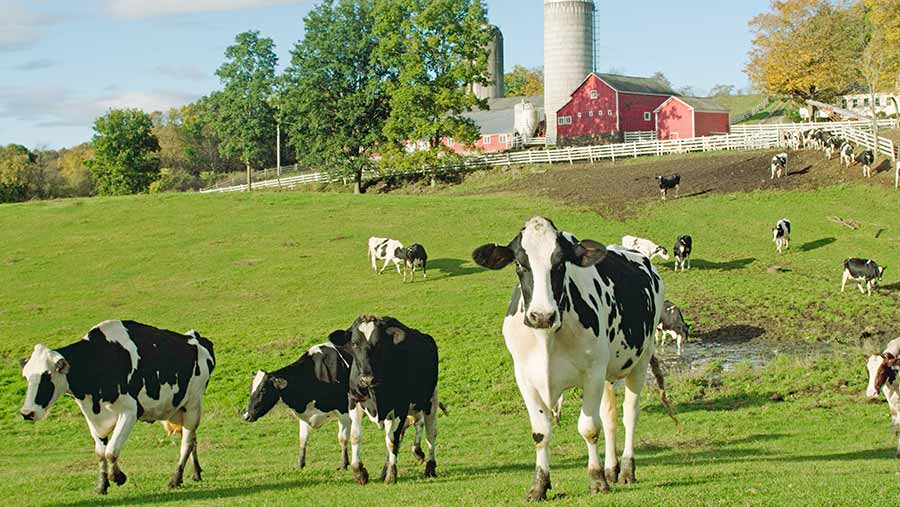6 key factors influencing dairy herd profitability
 © Design Pics Inc/Rex/Shutterstock
© Design Pics Inc/Rex/Shutterstock The importance of maintaining a long-lived herd by keeping cows healthy and reducing deaths are key to profitability during periods of milk price volatility.
Referencing benchmarking data from 65 US herds over the last 10 years, US dairy business consultant Matt Lange told the Mole Valley Farmers Optimum Lifetime Performance Dairy Conference at Haynes Motor Museum, Somerset that farms able to maintain a profit or break even during poor milk price have a number of factors in common.
“Death loss was a major driver as we had healthy cows that weren’t dying and we kept cull rate low. The more cows we get to the fourth and fifth lactation, the more money we’ll make,” he said.
See also: Sheep-to-dairy conversion helps treble farm profits
6 factors influencing profitability
- Low somatic cell counts – an indicator of herd health
- High energy-corrected milk
- Low death losses of 4-5% or better
- Lower net herd replacement cost (NHRC) – lower forced culling reduced NHRC loss and increased milk production (target less than 2.15ppl)
- Higher pregnancy rates – increasing pregnancy rates from 18% to 20% could bring £40 more profit per cow per year
- Good heifer survival
*Based on the top 25% of 65 US herds ranked on profitability over the last 10 years by The Compeer Financial Dairy Consulting Team
Mr Lange says that replacing a third lactation cow with a heifer is “highly inefficient” considering the fact cows actually only start to make money in their fourth lactation and beyond.
In fact, it is only halfway through their second lactation that heifer rearing costs alone are covered.
Additionally, if older animals are culled involuntarily in the first 60 days of lactation, they don’t even cover their dry cow costs.
He says producers should closely monitor key performance figures within their herds and act on results.
“Understand your death losses and herd replacement costs. It’s not just about how much things cost, but how much I have invested in them and my return on investment,” he said (see Net herd replacement costs).
Net herd replacement costs
Death losses should include any animal that dies on farm or is worthless at culling.
This impacts on net herd replacement costs (NHRC), which is the difference between an animal’s cull value and what she was valued at on farm.
For example, if a cow was valued at £1,500 and her cull value was £500, that equates to a £1,000 loss. At a 10% cull rate, this results in a £10,000 loss or £20,000 with a 20% cull rate.
Mr Lange says: “If you culled 18 animals that were valued at £1,500 (totalling £27,000) and you received on average £500 for them at culling (totalling £9,000), then you would have a £1,000 loss per animal or an £18,000 NHRC.
“Now take that £18,000 and divide it into the number of litres you shipped over that period and that is your NHRC on a per litre basis.”
Mr Lange says UK farmers should be targeting an NHRC of less than 2.15ppl. If NHRC is higher than this, producers should ask themselves why. Were there more dead cows?
Were they selling less milk? Had cull value reduced or culling rate gone up? Equally, when death rate is over a target 4-5%, farmers should look at areas such as feed and housing management.
Energy-corrected milk
Mr Lange said understanding milk contract requirements and how much farmers are getting paid for constituents is also an important factor.
He highlights the amount of energy-corrected milk produced on farm as a key influence on profitability and advises UK farmers to shift their attention towards this parameter.
“Farmers tend to focus on milk fat and protein percentages, but that’s irrelevant. It’s the total kilos you’re shipping,” he explained.
For example, a high-yielding herd may have low fat and protein percentages, but they may be selling more total constituents off farm. Equally, two herds with the same production could be producing very different levels of energy-corrected milk.
Income over feed
Tracking income over feed is another crucial factor, which links to understanding the return on investment for every input.
“That’s the most important metric. Am I getting what I’m paying for? I have a client with the highest milk per cow, but third from last on profit. Ask how much does it cost to produce that milk. It may be more profitable to be a 40-litre herd versus a 45-litre herd,” he said.
